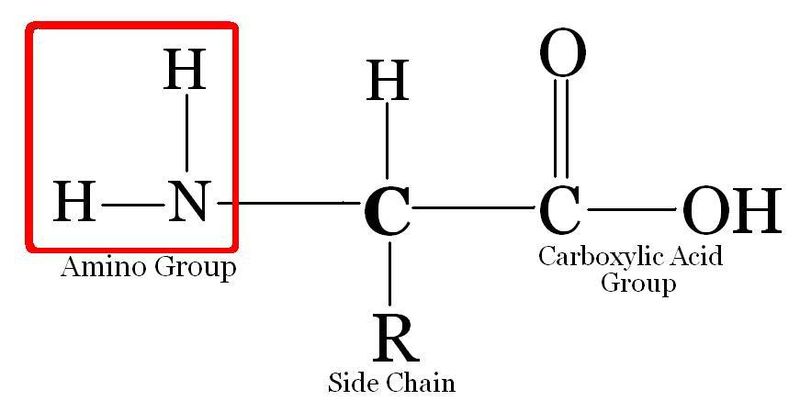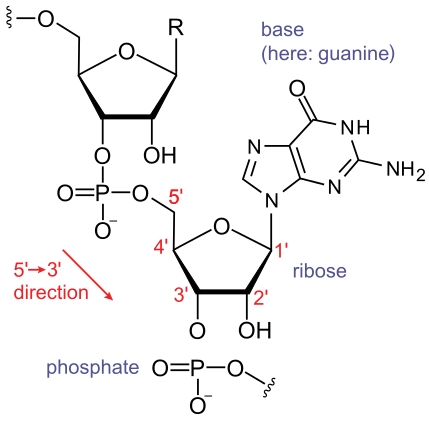Difference Between Amino Acid and Nucleic Acid
The key difference between amino acid and nucleic acid is that amino acids are the building blocks of proteins whereas nucleic acids are macromolecules made out of nucleotides.
Proteins and nucleic acids are essential components in living organisms. They are macromolecules containing hundreds of repeating units. Hence, a repeating unit represents the monomers or the building blocks that were used up in producing them. Amino acids are the monomers of proteins. Nucleotides are the monomers of nucleic acids.
CONTENTS
1. Overview and Key Difference
2. What is Amino Acid
3. What is Nucleic Acid
4. Side by Side Comparison – Amino Acid vs Nucleic Acid in Tabular Form
5. Summary
What is Amino Acid?
The amino acid is a simple molecule formed with C, H, O, N and sometimes Sulfur as well. There are about 20 common amino acids. All the amino acids have a –COOH, -NH2 groups and a –H bonded to a carbon. The carbon is a chiral carbon, and alpha-amino acids are the most important type in the biological world. Moreover, we cannot find D-amino acids in proteins and not a part of the metabolism of higher organisms.
However, several amino acids are important in the structure and metabolism of lower forms of life. In addition to common amino acids, there are some non-protein derived amino acids, many of which are either metabolic intermediates or parts of non-protein biomolecules (ornithine, citrulline). An amino acid has the following general structure.

Figure 01: Amino Acid Structure
The R group differs from amino acid to amino acid. Likewise, the simplest amino acid with the R group being H is glycine. Also, according to the R group, we can categorize the amino acids into different groups; such as aliphatic – aromatic, non-polar – polar, positively charged – negatively charged, or polar uncharged, etc. Furthermore, amino acids are present as zwitter ions in the physiological pH of 7.4.
Besides, amino acids are the building blocks of proteins. When two amino acids join to form a dipeptide, the combination takes place in a -NH2 group of one amino acid with the –COOH group of another amino acid. There, a peptide bond forms removing a water molecule. Likewise, thousands of amino acids can be condensed to form long peptides, which then undergo different folding patterns to make proteins.
What is Nucleic Acid?
Nucleic acids are macromolecules; they form via the combination of thousands of nucleotides. They have C, H, N, O and P. There are two major types of nucleic acids in biological systems; they are the DNA and RNA. They are the genetic material of an organism and are responsible for passing genetic characteristics from generation to generation.
Further, these compounds are important to control and maintain cellular functions. A nucleotide contains three units; they are the pentose sugar molecule, nitrogenous base, and phosphate group. According to the type of pentose sugar molecule, nitrogenous base, and the number of phosphate groups, the nucleotides differ from each other. For instance, in DNA, there is a deoxyribose sugar, and in RNA, there is a ribose sugar.

Figure 02: Nucleic Acid Structure
Moreover, there are mainly two groups of nitrogenous bases; they are the pyridines and pyrimidines. Cytosine, thymine, and uracil are examples for pyrimidine bases. Adenine and guanine are the two purine bases. DNA has adenine, Guanine, cytosine, and thymine bases, whereas RNA has A, G, C and uracil (instead of thymine).
In DNA and RNA, complementary bases form hydrogen bonds between them. Likewise, in those, adenine to thiamine (or uracil if it is RNA) and guanine to cytosine are complementary to each other. The phosphates groups can link with the –OH group of carbon 5 of the sugar. Nucleic acids form via combining nucleotides with phosphodiester bonds removing water molecules.
What is the Difference Between Amino Acid and Nucleic Acid?
Amino acids and nucleic acids are highly distinct from each other. The key difference between amino acid and nucleic acid is that amino acid is the building block of proteins whereas nucleic acids is a macromolecule made out of nucleotides. Therefore, amino acids are small molecules while nucleic acids are macromolecules.
Moreover, amino acids have C, H, O, N and S, whereas nucleic acids have C, H, O, N and P mainly. So, this is also an important difference between amino acids and nucleic acids. Furthermore, there are many types of amino acids such as essential amino acids, non-essential amino acids, etc. but there are only two major types of nucleic acids; they are DNA and RNA.
The below infographic on the difference between amino acid and nucleic acid shows these differences intabular form.

Summary – Amino Acid vs Nucleic Acid
Amino acids are simple molecules while nucleic acids are large molecules. Hence, the key difference between amino acid and nucleic acid is that amino acids are the building blocks of proteins whereas nucleic acids are macromolecules made out of nucleotides.
Reference:
1. Helmenstine, Anne Marie, Ph.D. “Nucleic Acids – Structure and Function.” ThoughtCo, Oct. 19, 2018. Available here
Image Courtesy:
1.”Amino Acid”By Tyagi.anuj – Own work, (CC BY 3.0) via Commons Wikimedia
2.”Ribonucleic acid chemical structure”By Warraich Sahib – Own work, (CC BY-SA 3.0) via Commons Wikimedia
ncG1vNJzZmivp6x7pbXFn5yrnZ6YsqOx07CcnqZemLyue8OinZ%2Bdopq7pLGMm5ytr5Wau26tzKKlqGWRmLalecCnm2auo2K7tq%2FLnqCcZZGYtqV7